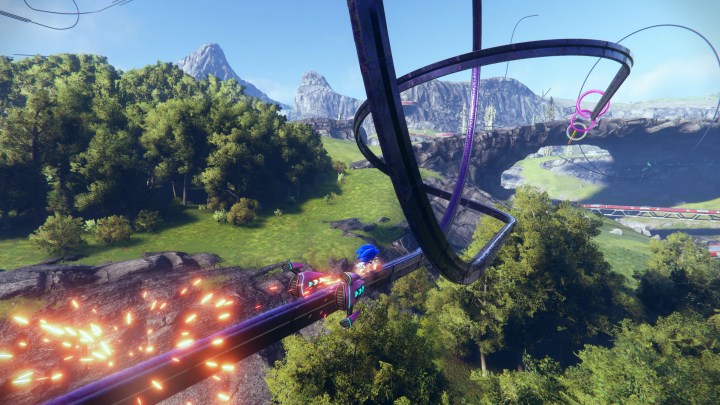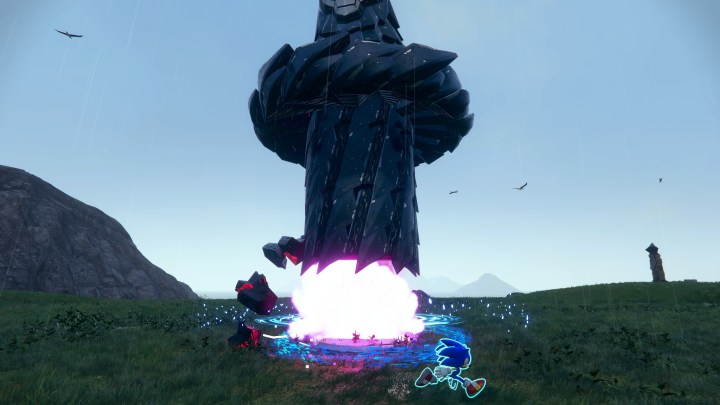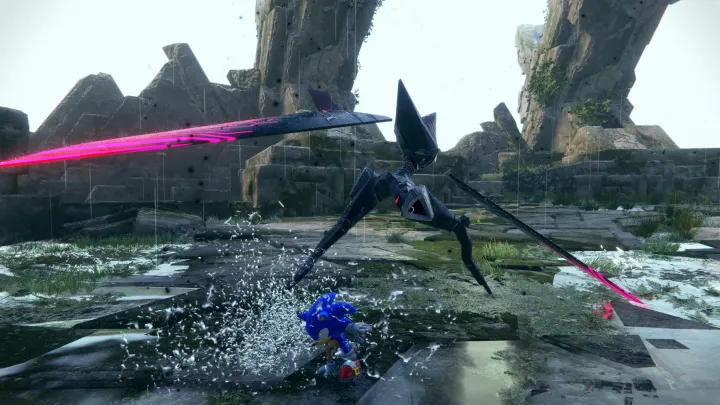
Ever since Sonic Frontiers was first revealed, it’s been a bit of a question mark for fans. The Breath of the Wild-like “open zone” gameplay certainly looked like a bold new direction for the franchise, but you can never expect a surefire win when it comes to Sonic and its eclectic history. I personally had no idea what to expect when I sat down for the game for a demo as part of Summer Game Fest; it could have been revolutionary or terrible.
After playing a 30-minute slice of it, I still have no idea what to think. All I can confidently say for now is that Sonic Frontiers is one of the weirdest AAA video games I’ve ever played.
Rolling around
My demo started right at the top of the game. Sonic wakes up in a grassy field after some unexplained occurrence separates him from Tails and Amy Rose. After a brief second of exposition, it was off to the races. I was dropped into a more linear introduction where I learned the basics of how to move, use my homing attack, and solve simple world puzzles. Soon after that, the world opened up and I was free to do whatever I wanted before my demo timer ran out.

In terms of pure game feel, my short experience was a bit mixed. On one hand, the open-zone formula is a refreshing change of pace. Previous Sonic games feel a bit like a rollercoaster with linear levels that feel guided. Here, it’s more of an amusement park. The world is dotted with disconnected micro-puzzles and platforming sections to jump between. At one point of interest, I’d race vertically up a tower to grab a collectible. At another, I’d homing-attack three stone structures to create a series of climbable platforms.
The design philosophy has already caused a point of confusion for fans who noted that assets like bumpers just kind of awkwardly hang in the air. It’s most certainly a little odd at first glance, but I was able to suspend my disbelief quickly enough and just enjoy all the little rides scattered around. It’s like going to a playground and hopping between the jungle gym and the slide.
What was harder to come to terms with was some of the basics, like controls and camera. Sonic Frontiers still feels like it has the same issues as many 3D Sonic titles. It’s hard to actually keep the momentum up and smoothly complete platforming sections as intended. I’d often initiate a quick sequence via a bumper or rail grind, only to come to a halt as I struggled to figure out the timing needed to successfully launch into a flying boost hoop. Similarly, one simple wall-running section became much harder as the camera got pancaked between narrow wall-running spots. Imagine if you were riding a rollercoaster and it just didn’t make it around a loop-de-loop. That’s how I felt at times, which lines up with other 3D Sonic titles.

Frontiers has an increased emphasis on combat too, but it was hard to get a sense of its depth in 30 minutes. I was mostly mashing one button to homing-attack enemies of all sizes, from tiny droids to a giant robot that I had to scale via boost rings. The homing attack feels oddly slow; there’s an ever-so-slight pause when Sonic strikes an enemy, emphasizing force over speed. The game does include a full skill tree with new moves, so I imagine it gets more complex later, but Sonic’s early toolset feels limited compared to the scale of the world around him.
I’m not sold on the open-zone concept just yet as the edges seem a little rough in the game’s current state, but I see the potential here. Open world games are all about jumping between points of interest and Sonic Frontiers makes those visual cues very clear. At the end of the demo, I was itching to line back up and see more rides.
Somber Sonic
The most indescribable feeling — the part that makes it so strange — is the game’s tone, which is bizarrely somber. Previous Sonic games play out like a Saturday morning cartoon with bright colors and lots of quips. Instead, Frontiers leans into quiet melodrama. Rather than sounding confident and full of life, Sonic almost sounds like he’s a dazed amnesiac. He’s a fish out of water on the island and that’s something we’ve never really seen in the series before.

The atmospheric music, decrepit landscapes, and concerned dialogue all become surreal when you remember you’re controlling a bright blue hedgehog who runs fast. It’s like playing a fan-made game from someone who’s a little too intense about the series.
Other elements feel similarly, and hilariously, out of place. There’s a roll dodge, RPG stat upgrades, and a stamina meter that depletes when Sonic’s speed boosts — yes, the character whose entire schtick is that he runs fast gets tired when he dashes for more than a few seconds. I sincerely respect that Sonic Team is taking such a bold leap with Frontiers, but I’d be lying if I said I didn’t play the demo with my head mostly cocked to the side in confusion.
The Sonic ethos
It would be easy for me to take a cynical route here and write off the experience as “bad,” like many will no matter how the final game is. But if I’m being honest, I couldn’t stop thinking about it for hours after I played. There’s a genuine sense of mystery to the world, some of which is intentional and some of which surely isn’t. Sega has done a great job of creating an unsettling, off-kilter world that feels quietly unsettling.

Though I’m even more just mystified by the game design decisions. None of this feels like a fit for Sonic, and that makes the entire experience feel invitingly surreal. It feels like playing The Legend of Zelda: Link’s Awakening for the first time and watching Link interact with Goombas. It doesn’t make sense, but that brings a dreamlike quality to the experience.
Is that intentional? I doubt it. But who cares?
At this point, the Sonic franchise is built on irony as much as it is sincerity. Sonic Team’s experimental edge has produced some truly gonzo games that all add to the series’ enduring legacy (see Shadow the Hedgehog or Sonic 06). Whether it’s “good” or “bad” — again, I truly could not tell you based on my time with it — is irrelevant. What matters is that it’s the kind of mystifying Sonic experience that’ll only add to its bizarre memelord ethos.
Sonic Frontiers is scheduled to launch sometime this year.



